Strategy in Organisations: Formulation, Implementation & Evaluation
VerifiedAdded on 2023/06/18
|7
|1528
|478
Report
AI Summary
This report elucidates the pivotal role of business strategy in defining an organization's future direction and outlines the steps involved in strategy formulation, including environmental analysis, mission definition, objective setting, competitive strategy development, implementation, and progress evaluation. It provides an example of Diageo to illustrate the concept of competitive advantage, contrasting strategy formulation and implementation, highlighting the rational decision-making versus the operational processes. Furthermore, the report details the strategy evaluation process, emphasizing performance measurement, variance analysis, and corrective action, underscoring its importance in achieving desired strategic outcomes. Desklib offers a platform to explore similar solved assignments and past papers for students.
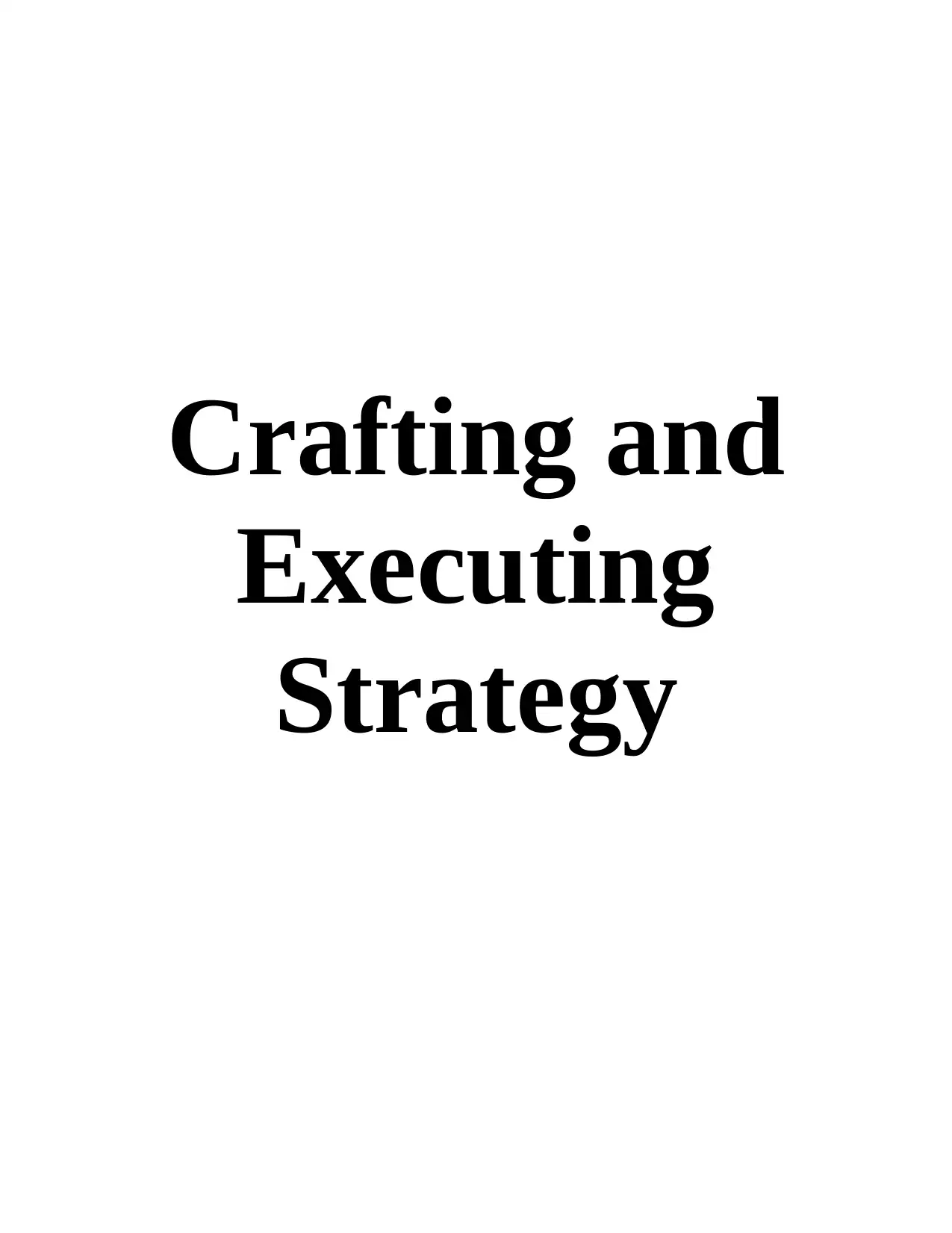
Crafting and
Executing
Strategy
Executing
Strategy
Paraphrase This Document
Need a fresh take? Get an instant paraphrase of this document with our AI Paraphraser
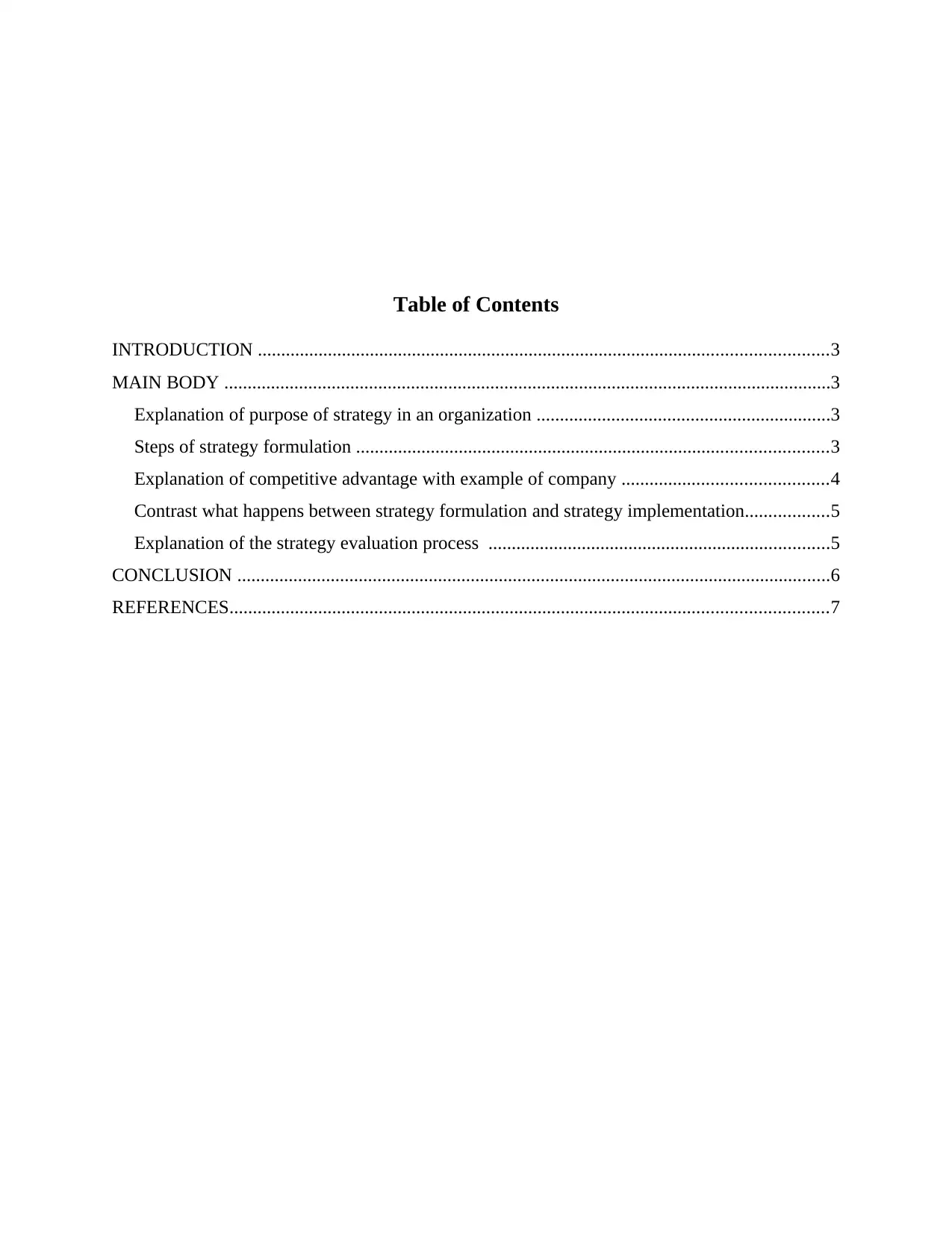
Table of Contents
INTRODUCTION ..........................................................................................................................3
MAIN BODY ..................................................................................................................................3
Explanation of purpose of strategy in an organization ...............................................................3
Steps of strategy formulation .....................................................................................................3
Explanation of competitive advantage with example of company ............................................4
Contrast what happens between strategy formulation and strategy implementation..................5
Explanation of the strategy evaluation process .........................................................................5
CONCLUSION ...............................................................................................................................6
REFERENCES................................................................................................................................7
INTRODUCTION ..........................................................................................................................3
MAIN BODY ..................................................................................................................................3
Explanation of purpose of strategy in an organization ...............................................................3
Steps of strategy formulation .....................................................................................................3
Explanation of competitive advantage with example of company ............................................4
Contrast what happens between strategy formulation and strategy implementation..................5
Explanation of the strategy evaluation process .........................................................................5
CONCLUSION ...............................................................................................................................6
REFERENCES................................................................................................................................7
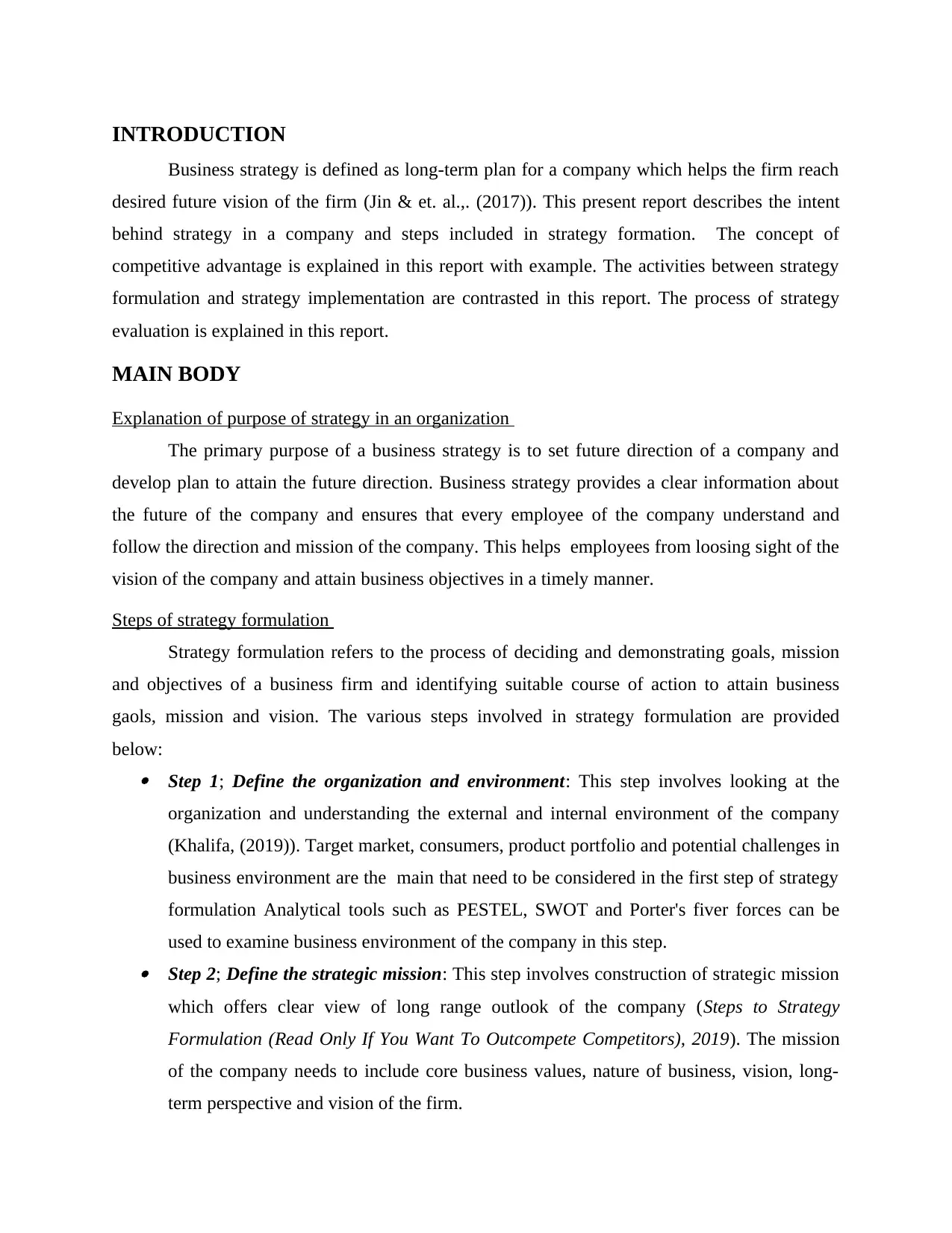
INTRODUCTION
Business strategy is defined as long-term plan for a company which helps the firm reach
desired future vision of the firm (Jin & et. al.,. (2017)). This present report describes the intent
behind strategy in a company and steps included in strategy formation. The concept of
competitive advantage is explained in this report with example. The activities between strategy
formulation and strategy implementation are contrasted in this report. The process of strategy
evaluation is explained in this report.
MAIN BODY
Explanation of purpose of strategy in an organization
The primary purpose of a business strategy is to set future direction of a company and
develop plan to attain the future direction. Business strategy provides a clear information about
the future of the company and ensures that every employee of the company understand and
follow the direction and mission of the company. This helps employees from loosing sight of the
vision of the company and attain business objectives in a timely manner.
Steps of strategy formulation
Strategy formulation refers to the process of deciding and demonstrating goals, mission
and objectives of a business firm and identifying suitable course of action to attain business
gaols, mission and vision. The various steps involved in strategy formulation are provided
below: Step 1; Define the organization and environment: This step involves looking at the
organization and understanding the external and internal environment of the company
(Khalifa, (2019)). Target market, consumers, product portfolio and potential challenges in
business environment are the main that need to be considered in the first step of strategy
formulation Analytical tools such as PESTEL, SWOT and Porter's fiver forces can be
used to examine business environment of the company in this step. Step 2; Define the strategic mission: This step involves construction of strategic mission
which offers clear view of long range outlook of the company (Steps to Strategy
Formulation (Read Only If You Want To Outcompete Competitors), 2019). The mission
of the company needs to include core business values, nature of business, vision, long-
term perspective and vision of the firm.
Business strategy is defined as long-term plan for a company which helps the firm reach
desired future vision of the firm (Jin & et. al.,. (2017)). This present report describes the intent
behind strategy in a company and steps included in strategy formation. The concept of
competitive advantage is explained in this report with example. The activities between strategy
formulation and strategy implementation are contrasted in this report. The process of strategy
evaluation is explained in this report.
MAIN BODY
Explanation of purpose of strategy in an organization
The primary purpose of a business strategy is to set future direction of a company and
develop plan to attain the future direction. Business strategy provides a clear information about
the future of the company and ensures that every employee of the company understand and
follow the direction and mission of the company. This helps employees from loosing sight of the
vision of the company and attain business objectives in a timely manner.
Steps of strategy formulation
Strategy formulation refers to the process of deciding and demonstrating goals, mission
and objectives of a business firm and identifying suitable course of action to attain business
gaols, mission and vision. The various steps involved in strategy formulation are provided
below: Step 1; Define the organization and environment: This step involves looking at the
organization and understanding the external and internal environment of the company
(Khalifa, (2019)). Target market, consumers, product portfolio and potential challenges in
business environment are the main that need to be considered in the first step of strategy
formulation Analytical tools such as PESTEL, SWOT and Porter's fiver forces can be
used to examine business environment of the company in this step. Step 2; Define the strategic mission: This step involves construction of strategic mission
which offers clear view of long range outlook of the company (Steps to Strategy
Formulation (Read Only If You Want To Outcompete Competitors), 2019). The mission
of the company needs to include core business values, nature of business, vision, long-
term perspective and vision of the firm.
⊘ This is a preview!⊘
Do you want full access?
Subscribe today to unlock all pages.

Trusted by 1+ million students worldwide
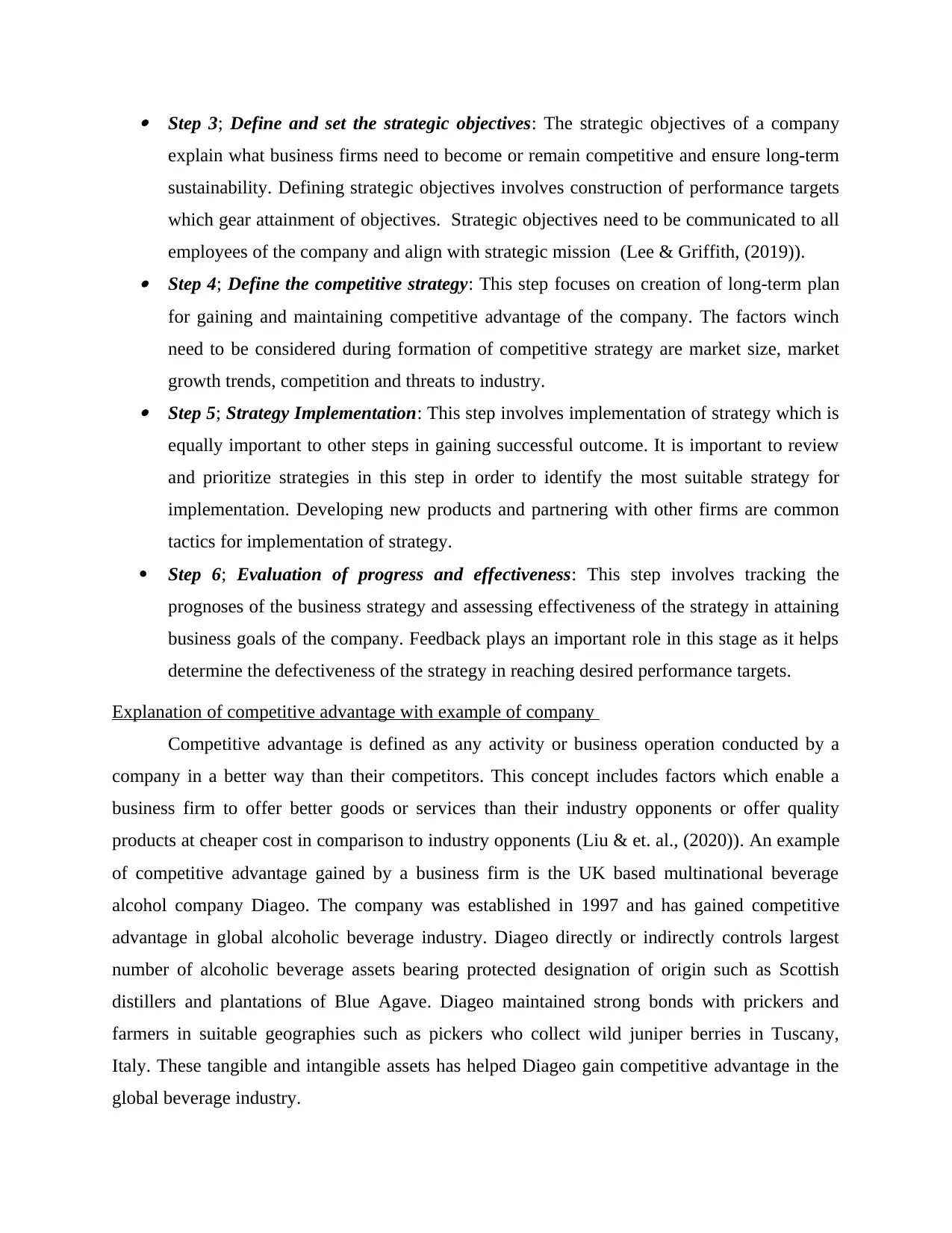
Step 3; Define and set the strategic objectives: The strategic objectives of a company
explain what business firms need to become or remain competitive and ensure long-term
sustainability. Defining strategic objectives involves construction of performance targets
which gear attainment of objectives. Strategic objectives need to be communicated to all
employees of the company and align with strategic mission (Lee & Griffith, (2019)). Step 4; Define the competitive strategy: This step focuses on creation of long-term plan
for gaining and maintaining competitive advantage of the company. The factors winch
need to be considered during formation of competitive strategy are market size, market
growth trends, competition and threats to industry. Step 5; Strategy Implementation: This step involves implementation of strategy which is
equally important to other steps in gaining successful outcome. It is important to review
and prioritize strategies in this step in order to identify the most suitable strategy for
implementation. Developing new products and partnering with other firms are common
tactics for implementation of strategy.
Step 6; Evaluation of progress and effectiveness: This step involves tracking the
prognoses of the business strategy and assessing effectiveness of the strategy in attaining
business goals of the company. Feedback plays an important role in this stage as it helps
determine the defectiveness of the strategy in reaching desired performance targets.
Explanation of competitive advantage with example of company
Competitive advantage is defined as any activity or business operation conducted by a
company in a better way than their competitors. This concept includes factors which enable a
business firm to offer better goods or services than their industry opponents or offer quality
products at cheaper cost in comparison to industry opponents (Liu & et. al., (2020)). An example
of competitive advantage gained by a business firm is the UK based multinational beverage
alcohol company Diageo. The company was established in 1997 and has gained competitive
advantage in global alcoholic beverage industry. Diageo directly or indirectly controls largest
number of alcoholic beverage assets bearing protected designation of origin such as Scottish
distillers and plantations of Blue Agave. Diageo maintained strong bonds with prickers and
farmers in suitable geographies such as pickers who collect wild juniper berries in Tuscany,
Italy. These tangible and intangible assets has helped Diageo gain competitive advantage in the
global beverage industry.
explain what business firms need to become or remain competitive and ensure long-term
sustainability. Defining strategic objectives involves construction of performance targets
which gear attainment of objectives. Strategic objectives need to be communicated to all
employees of the company and align with strategic mission (Lee & Griffith, (2019)). Step 4; Define the competitive strategy: This step focuses on creation of long-term plan
for gaining and maintaining competitive advantage of the company. The factors winch
need to be considered during formation of competitive strategy are market size, market
growth trends, competition and threats to industry. Step 5; Strategy Implementation: This step involves implementation of strategy which is
equally important to other steps in gaining successful outcome. It is important to review
and prioritize strategies in this step in order to identify the most suitable strategy for
implementation. Developing new products and partnering with other firms are common
tactics for implementation of strategy.
Step 6; Evaluation of progress and effectiveness: This step involves tracking the
prognoses of the business strategy and assessing effectiveness of the strategy in attaining
business goals of the company. Feedback plays an important role in this stage as it helps
determine the defectiveness of the strategy in reaching desired performance targets.
Explanation of competitive advantage with example of company
Competitive advantage is defined as any activity or business operation conducted by a
company in a better way than their competitors. This concept includes factors which enable a
business firm to offer better goods or services than their industry opponents or offer quality
products at cheaper cost in comparison to industry opponents (Liu & et. al., (2020)). An example
of competitive advantage gained by a business firm is the UK based multinational beverage
alcohol company Diageo. The company was established in 1997 and has gained competitive
advantage in global alcoholic beverage industry. Diageo directly or indirectly controls largest
number of alcoholic beverage assets bearing protected designation of origin such as Scottish
distillers and plantations of Blue Agave. Diageo maintained strong bonds with prickers and
farmers in suitable geographies such as pickers who collect wild juniper berries in Tuscany,
Italy. These tangible and intangible assets has helped Diageo gain competitive advantage in the
global beverage industry.
Paraphrase This Document
Need a fresh take? Get an instant paraphrase of this document with our AI Paraphraser
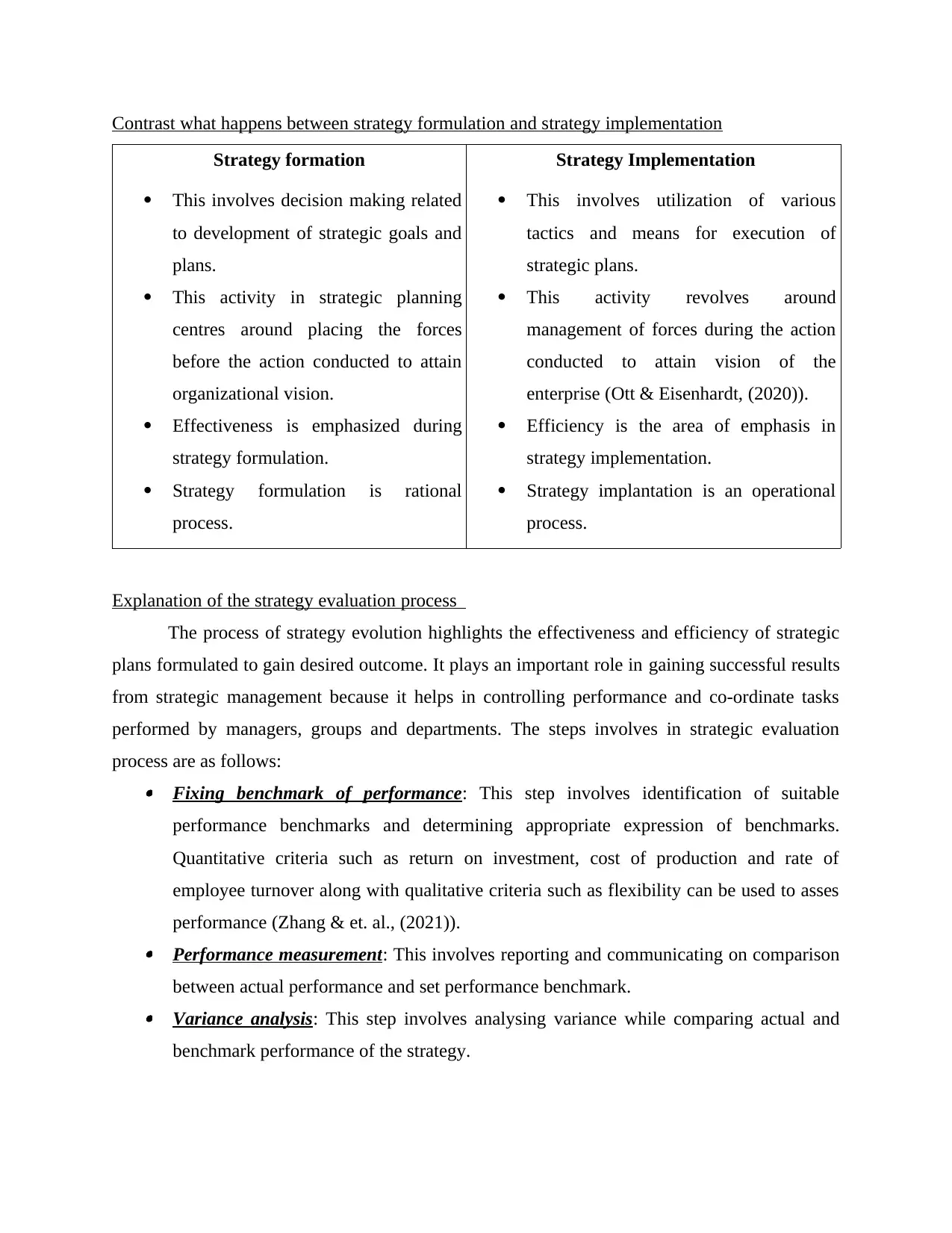
Contrast what happens between strategy formulation and strategy implementation
Strategy formation Strategy Implementation
This involves decision making related
to development of strategic goals and
plans.
This activity in strategic planning
centres around placing the forces
before the action conducted to attain
organizational vision.
Effectiveness is emphasized during
strategy formulation.
Strategy formulation is rational
process.
This involves utilization of various
tactics and means for execution of
strategic plans.
This activity revolves around
management of forces during the action
conducted to attain vision of the
enterprise (Ott & Eisenhardt, (2020)).
Efficiency is the area of emphasis in
strategy implementation.
Strategy implantation is an operational
process.
Explanation of the strategy evaluation process
The process of strategy evolution highlights the effectiveness and efficiency of strategic
plans formulated to gain desired outcome. It plays an important role in gaining successful results
from strategic management because it helps in controlling performance and co-ordinate tasks
performed by managers, groups and departments. The steps involves in strategic evaluation
process are as follows: Fixing benchmark of performance: This step involves identification of suitable
performance benchmarks and determining appropriate expression of benchmarks.
Quantitative criteria such as return on investment, cost of production and rate of
employee turnover along with qualitative criteria such as flexibility can be used to asses
performance (Zhang & et. al., (2021)). Performance measurement: This involves reporting and communicating on comparison
between actual performance and set performance benchmark. Variance analysis: This step involves analysing variance while comparing actual and
benchmark performance of the strategy.
Strategy formation Strategy Implementation
This involves decision making related
to development of strategic goals and
plans.
This activity in strategic planning
centres around placing the forces
before the action conducted to attain
organizational vision.
Effectiveness is emphasized during
strategy formulation.
Strategy formulation is rational
process.
This involves utilization of various
tactics and means for execution of
strategic plans.
This activity revolves around
management of forces during the action
conducted to attain vision of the
enterprise (Ott & Eisenhardt, (2020)).
Efficiency is the area of emphasis in
strategy implementation.
Strategy implantation is an operational
process.
Explanation of the strategy evaluation process
The process of strategy evolution highlights the effectiveness and efficiency of strategic
plans formulated to gain desired outcome. It plays an important role in gaining successful results
from strategic management because it helps in controlling performance and co-ordinate tasks
performed by managers, groups and departments. The steps involves in strategic evaluation
process are as follows: Fixing benchmark of performance: This step involves identification of suitable
performance benchmarks and determining appropriate expression of benchmarks.
Quantitative criteria such as return on investment, cost of production and rate of
employee turnover along with qualitative criteria such as flexibility can be used to asses
performance (Zhang & et. al., (2021)). Performance measurement: This involves reporting and communicating on comparison
between actual performance and set performance benchmark. Variance analysis: This step involves analysing variance while comparing actual and
benchmark performance of the strategy.
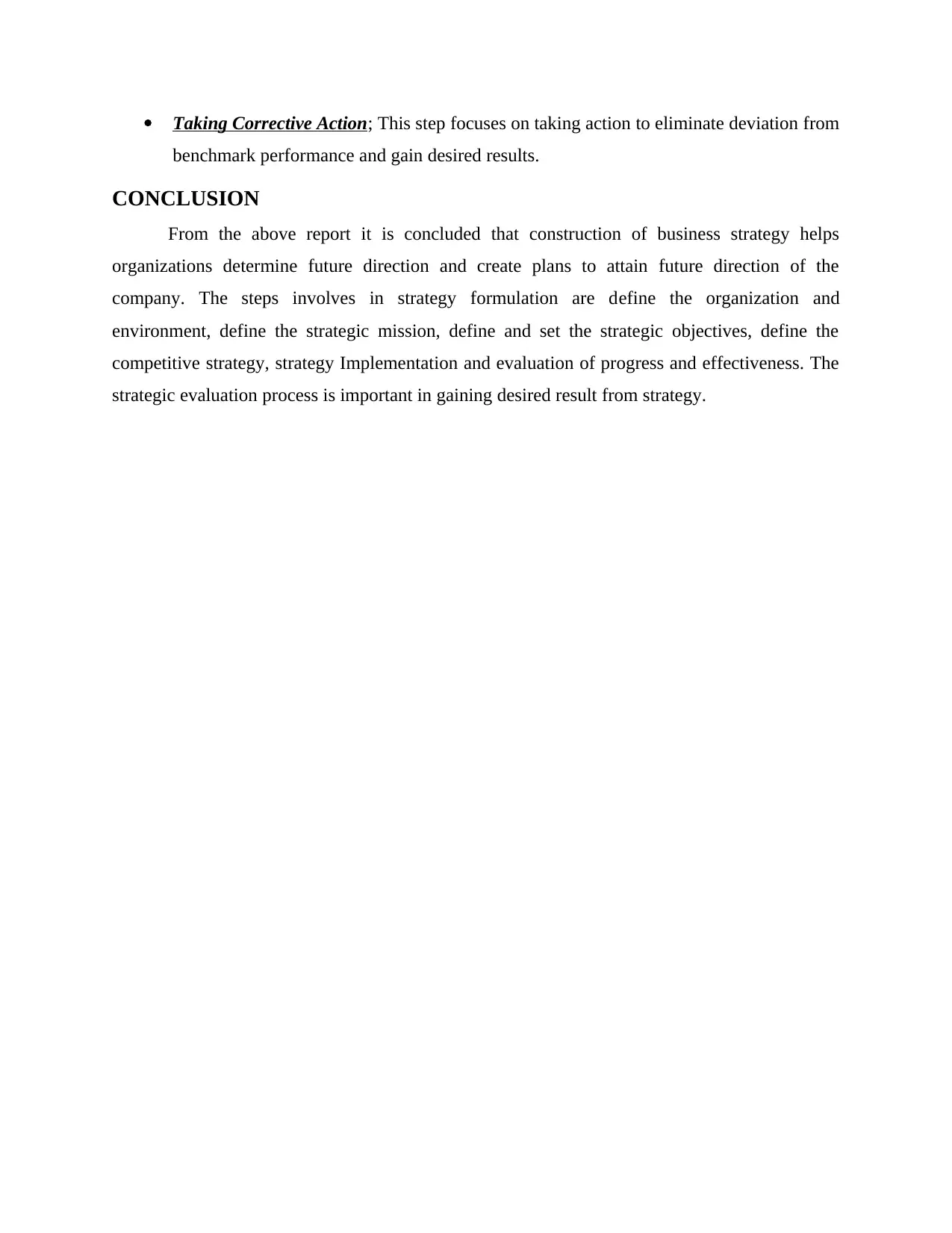
Taking Corrective Action; This step focuses on taking action to eliminate deviation from
benchmark performance and gain desired results.
CONCLUSION
From the above report it is concluded that construction of business strategy helps
organizations determine future direction and create plans to attain future direction of the
company. The steps involves in strategy formulation are define the organization and
environment, define the strategic mission, define and set the strategic objectives, define the
competitive strategy, strategy Implementation and evaluation of progress and effectiveness. The
strategic evaluation process is important in gaining desired result from strategy.
benchmark performance and gain desired results.
CONCLUSION
From the above report it is concluded that construction of business strategy helps
organizations determine future direction and create plans to attain future direction of the
company. The steps involves in strategy formulation are define the organization and
environment, define the strategic mission, define and set the strategic objectives, define the
competitive strategy, strategy Implementation and evaluation of progress and effectiveness. The
strategic evaluation process is important in gaining desired result from strategy.
⊘ This is a preview!⊘
Do you want full access?
Subscribe today to unlock all pages.

Trusted by 1+ million students worldwide
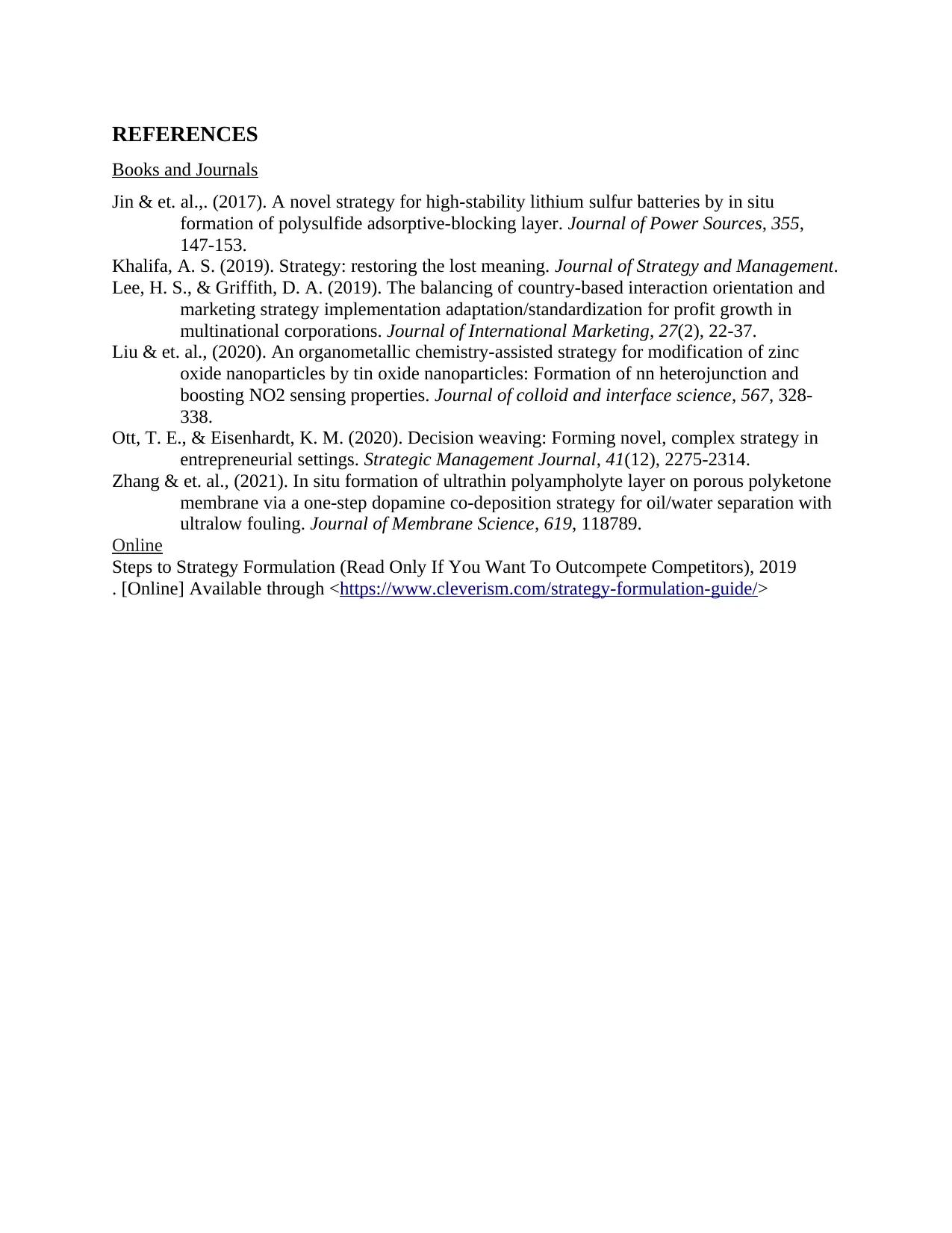
REFERENCES
Books and Journals
Jin & et. al.,. (2017). A novel strategy for high-stability lithium sulfur batteries by in situ
formation of polysulfide adsorptive-blocking layer. Journal of Power Sources, 355,
147-153.
Khalifa, A. S. (2019). Strategy: restoring the lost meaning. Journal of Strategy and Management.
Lee, H. S., & Griffith, D. A. (2019). The balancing of country-based interaction orientation and
marketing strategy implementation adaptation/standardization for profit growth in
multinational corporations. Journal of International Marketing, 27(2), 22-37.
Liu & et. al., (2020). An organometallic chemistry-assisted strategy for modification of zinc
oxide nanoparticles by tin oxide nanoparticles: Formation of nn heterojunction and
boosting NO2 sensing properties. Journal of colloid and interface science, 567, 328-
338.
Ott, T. E., & Eisenhardt, K. M. (2020). Decision weaving: Forming novel, complex strategy in
entrepreneurial settings. Strategic Management Journal, 41(12), 2275-2314.
Zhang & et. al., (2021). In situ formation of ultrathin polyampholyte layer on porous polyketone
membrane via a one-step dopamine co-deposition strategy for oil/water separation with
ultralow fouling. Journal of Membrane Science, 619, 118789.
Online
Steps to Strategy Formulation (Read Only If You Want To Outcompete Competitors), 2019
. [Online] Available through <https://www.cleverism.com/strategy-formulation-guide/>
Books and Journals
Jin & et. al.,. (2017). A novel strategy for high-stability lithium sulfur batteries by in situ
formation of polysulfide adsorptive-blocking layer. Journal of Power Sources, 355,
147-153.
Khalifa, A. S. (2019). Strategy: restoring the lost meaning. Journal of Strategy and Management.
Lee, H. S., & Griffith, D. A. (2019). The balancing of country-based interaction orientation and
marketing strategy implementation adaptation/standardization for profit growth in
multinational corporations. Journal of International Marketing, 27(2), 22-37.
Liu & et. al., (2020). An organometallic chemistry-assisted strategy for modification of zinc
oxide nanoparticles by tin oxide nanoparticles: Formation of nn heterojunction and
boosting NO2 sensing properties. Journal of colloid and interface science, 567, 328-
338.
Ott, T. E., & Eisenhardt, K. M. (2020). Decision weaving: Forming novel, complex strategy in
entrepreneurial settings. Strategic Management Journal, 41(12), 2275-2314.
Zhang & et. al., (2021). In situ formation of ultrathin polyampholyte layer on porous polyketone
membrane via a one-step dopamine co-deposition strategy for oil/water separation with
ultralow fouling. Journal of Membrane Science, 619, 118789.
Online
Steps to Strategy Formulation (Read Only If You Want To Outcompete Competitors), 2019
. [Online] Available through <https://www.cleverism.com/strategy-formulation-guide/>
1 out of 7
Related Documents
Your All-in-One AI-Powered Toolkit for Academic Success.
+13062052269
info@desklib.com
Available 24*7 on WhatsApp / Email
![[object Object]](/_next/static/media/star-bottom.7253800d.svg)
Unlock your academic potential
Copyright © 2020–2025 A2Z Services. All Rights Reserved. Developed and managed by ZUCOL.



